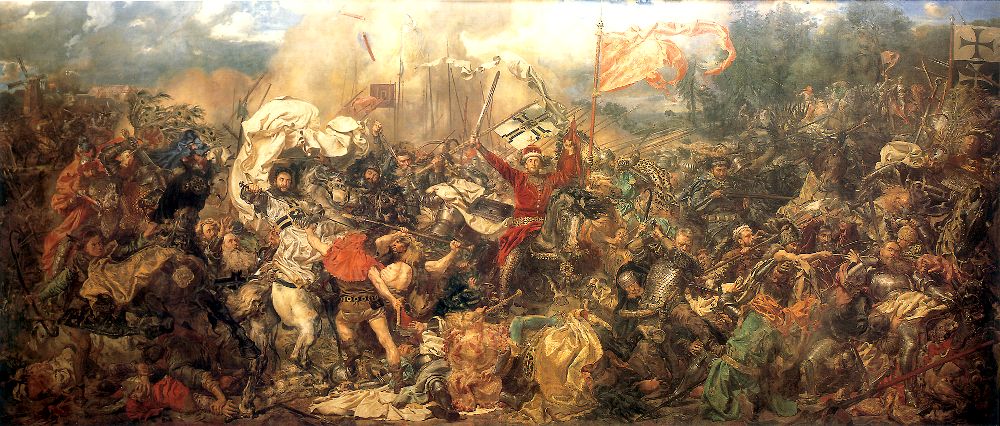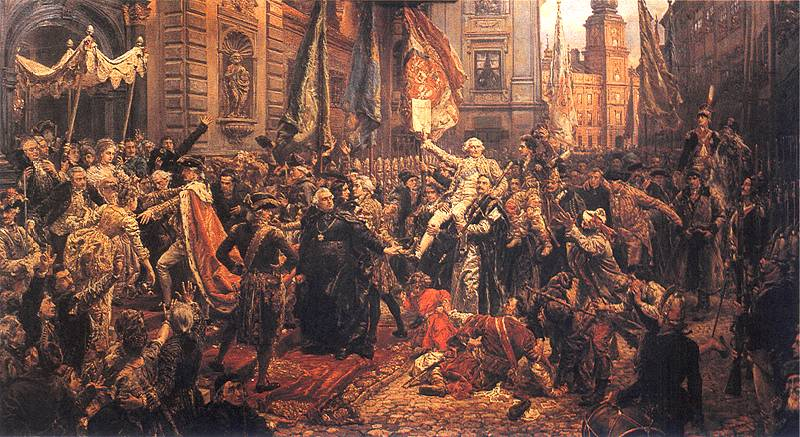
Reserved Area
Artists - ArtWorks
Jan Matejko
 Poland
PolandThe XIX Century Painting
Jan Matejko 1838-1893
- The Battle of Grunwald
- The Constitution Act of the 3rd May
Jan Matejko was studying In the Fine Arts Academy in Cracow(1852-58), in Munich and in Vienna (1859-1860), since 1873 he was the director of the Fine Arts Academy in Cracow. His main masterpieces were dedicated to his motherland’s history, which were supported by very elaborated historic studies.
Fundamental masterpieces are: Stanczyk, Skarga’s Homily, Polonia-1863, Rejtan, Union of Lublin, Stefan Batory at Pskow, Hanging on the Zygmunt’s Bell, The Battle of Grunwald, The Prussian Homage, Jan Sobieski at Vienna, Kosciuszko at Raclawice, The Constitution Act of the 3rd May.
Matejko was also painting portraits and creating drawings (the collection of Polish Kings and Princes, he was also making polychromic in the St. Mary Church in Cracow. He was awarded with many prizes and emblems (1870- the French Honored Legion) .He was a tutor of many successive Polish painters.
The painter lives and creates In the country which Since 1772 is occupied and divided into 3 superpowers: Russia, Austria and Prussia. After the 3rd division of Poland, actually the Polish country has disappeared. Cracow remains under Austria’s regulations, and though Galicia is apparently most archaic zone while taking economics into consideration, there is some autonomy allowed there. Matejko may without any problems create various paintings illustrating the glorious cards of the Polish history.
In XIX century In Poland there were made realistic paintings, Only Matejko’s tutees, e.g. Jacek Malczewski were creating masterpieces In which symbolism was dominating. In that period In Europe, the front stage was occupied by the realistic painting. The main representatives of that period in Poland were: Jan Piotr Norblin, Juliusz Kossak, Piotr Michalowski, Stanisław Wyspianski i Jozef Chelmonski.
The realistic painting- historic and battlefield was developer by many painters. Piotr Michalowski was painting Napoleon Epoch’s battles, insurrections. Jan Piotr Norblin was first of all interested In the Kosciuszko’s Insurrection. Jozef Brandt was presenting the Polish- Swedish Wars. All of them were unified in their interest in history and realism.
Jan Matejko’s Picture visualise a depth of historic plot thinking, they are not only colourful anecdotes, but also the synthesis of the common historic knowledge. Every painted history is accompanied by a feeling person. The pictures’ characters are featured with their heroism, their gestures are pathetic, their glances are full of monumental posture. The very expressional paintings are full of drama corresponding to the situations focused on.
Jan Matejko was fascinated by the Italian Late Renaissance Painting, e.g. Titian, who in the course of his paintings was presenting colorful spectacles similar to theatre’s scenes.
Jan Matejko since mid-50s. was creating mainly motherland dedicated masterpieces, starting from very precise historic and monuments considered studies. Most of them is compositions of very big size, which are featured by combining realism and documentary precision of details with dynamical compositions of paintings on their whole. Matejko was also painting portraits and self portraits. There is also known his cycle of drawings: “The Collection of Polish Kings and Princes”. The painter was also designing polychromic in the St. Mary Church in Cracow, and besides he was painting pictures moving the religion contexts.
Nobody else among the Polish painters has painted so many valuable historic masterpieces, presenting the most glorious cards of the Polish history. Also, nobody else was an equally great patriot in the artistic action. The Matejko’s paintings are perfectly matching with the function of teaching history, the epoch’s costumes and all the battlefield scenery expressed by the former formations of the Polish troops. The characters of the Polish Kings very easily are coming into Polish students’ consciousness Just thanks to Matejko’s drawings.
www.wikipedia.org/wiki/Jan_Matejko, www.wawel.net
(Polskie malarstwo historyczne i batalistyczne), www.jan-matejko-pl.com
www.culture.pl/en/culture/artykuly/os_matejko_jan www.pinakoteka.zascianek.pl/Matejko/Grunwald.htm
Related Material:
Image available

File name: 44_Grunwald.jpg
Description of the material:
http://www.speedyshare.com/data/645999707/10801983/27038828/The%20battle%20of%20Grunwald.jpg http://www.speedyshare.com/data/262856955/10801991/15106743/The%20constitution%20of%203th%20May.jpg File’s extension
Contextualisation Of the source:
The picture ”The Battle of Grunwald” remains In the National Museum In Warsaw. It can be also observed on many net pages after filling In the password: “Jan Matejko” or “The National Museum in Warsaw”. The picture „The Constitution of the 3rd May” can be studied In the Royal Castle In Warsaw and on the mentioned before net pages.
Interpretation of the source:
„The Battle of Grunwald” presents the battle in 1410 between the Cross Knights’ State and the Polish- Lithuanian troops led by the King Wladyslaw Jagiello. The battle with a great memorable Polish victory. „The Act of Constitution of the 3rd May” writes in our collective memory the Day of celebration of the most modern and democratic constitution In Europe, in 1791. Those both events remains still a great glory of the Polish nation.

File name: 44_Poland- XIX Century- Jan Matejko 2008r_the battle of grunwald.bmp
Description of the material:
„The Battle of Grunwald” is an oiled Picture at the size of proportions: 426cm/987cm
Contextualisation Of the source:
The picture ”The Battle of Grunwald” remains In the National Museum In Warsaw. It can be also observed on many net pages after filling In the password: “Jan Matejko” or “The National Museum in Warsaw”.
Interpretation of the source:
„The Battle of Grunwald” presents the battle in 1410 between the Cross Knights’ State and the Polish- Lithuanian troops led by the King Wladyslaw Jagiello. The battle with a great memorable Polish victory. This event remains still a great glory of the Polish nation.

File name: 44_Poland- XIX Century- Jan Matejko 2008r_the constitution of 3rd may.bmp
Description of the material:
„The Constitution Act of the 3rd May” is an oiled picture at the size of the proportions: 242cm/446cm
Contextualisation Of the source:
The picture „The Constitution of the 3rd May” can be studied In the Royal Castle In Warsaw and on the mentioned before net pages.
Interpretation of the source:
„The Act of Constitution of the 3rd May” writes in our collective memory the Day of celebration of the most modern and democratic constitution In Europe, in 1791. This event remains still a great glory of the Polish nation.
Comments about this Artist/ArtWork
Date: 2009.05.22
Posted by Teodora Zeia, National School of Arts "Dobri Hristov"-Varna, Bulgaria
Message: When thinking of Polish art, my first impulse is to visualize Jan Matejko’s paintings. One of my favorite paintings is “Bitwa pod Warna”, painted in 1879, illustrating the tragic battle near Varna, in which the armies of Wladyslaw III (who is remembered as Wladyslaw Warnenczyk by Bulgarians and especially by the citizens of Varna) were defeated by Murad II. This painting has always moved me deeply as it inspires so many emotions- it streams power, impetuosity, rage… and at the same time there is an implication of predestination. Wladyslaw Jagelo loses his life in this battle. In the justification section of Jan Matejko’s presentation it is said that “Nobody else among the Polish painters has painted so many valuable historic masterpieces”, “nobody else was an equally great patriot” and that “Matejko’s paintings are perfectly matching with the function of teaching history, the epoch’s costumes and all the battlefield scenery”. I would like to express my personal opinion that Jan Matjeko is not only one of the greatest Polish artists, but one of the greatest masters in the art history of the world. And not only due to the above-mentioned facts, but also because of the powerful and unforgettable impact his masterpieces have on the spectator- an impact, achieved not only by the reflection of the historic reality, the motion, dynamics, colour, the lights and shadow, the detailed magnificent costumes and shining armour. I believe that one of the reasons why his painting are so gripping, is the psychological presence of Matejko’s characters. They have such powerful, tangible presence, their faces move the spectator with their lifelike expressions- sometimes radiating tranquillity and sometimes stirred with overwhelming emotions. Some of the most psychologically compelling characters I have seen are those of kardynal Hosjusz ( Unia lubelska), Tadeusz Rejtan ( Rejtan na sejmie warszawskim), the portrait of kasztelanki Stanislawy Serafinskiej and Stanczyk.
Michelangelo - Copyright 2008 - This project has been funded with support from the European Commission